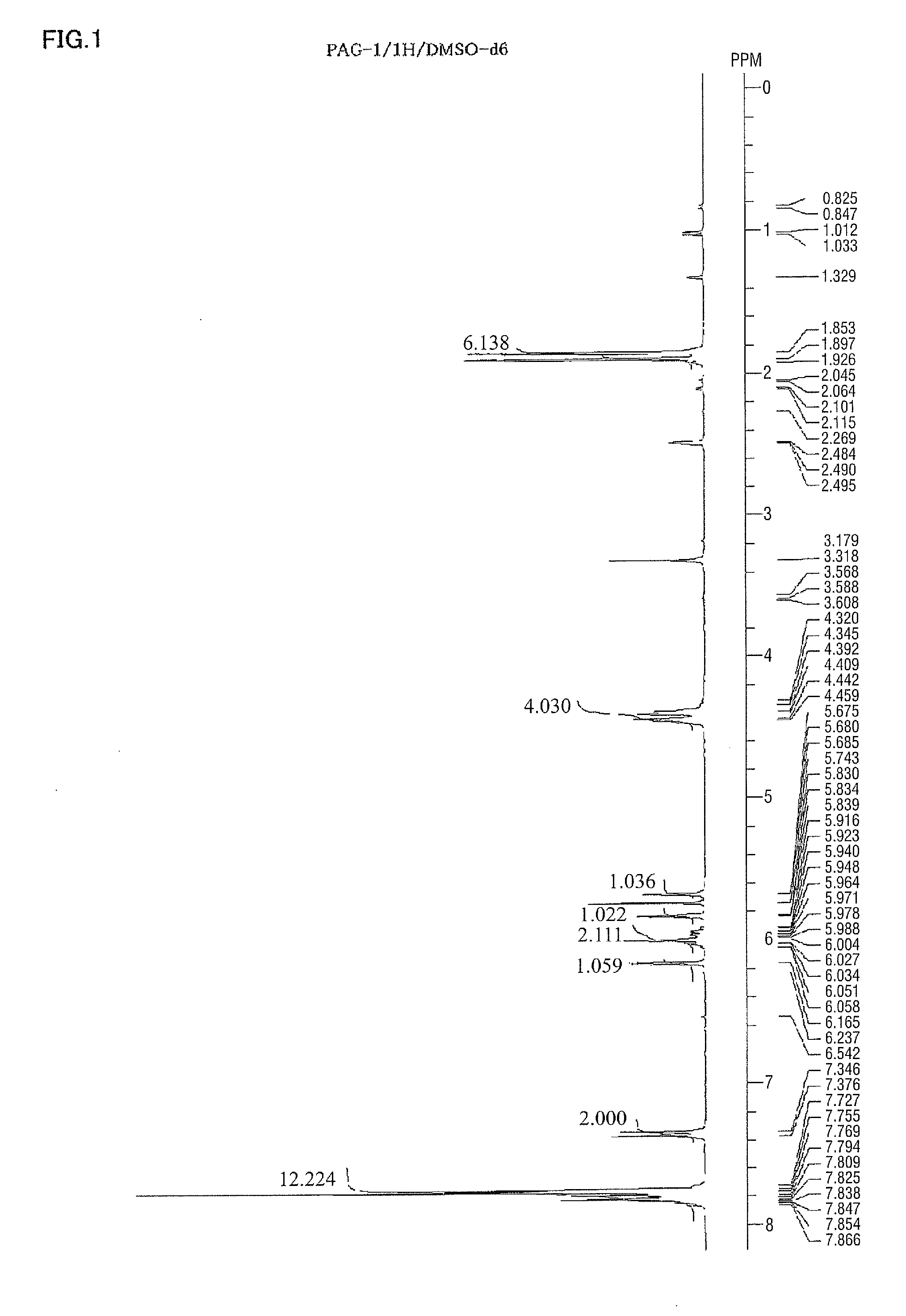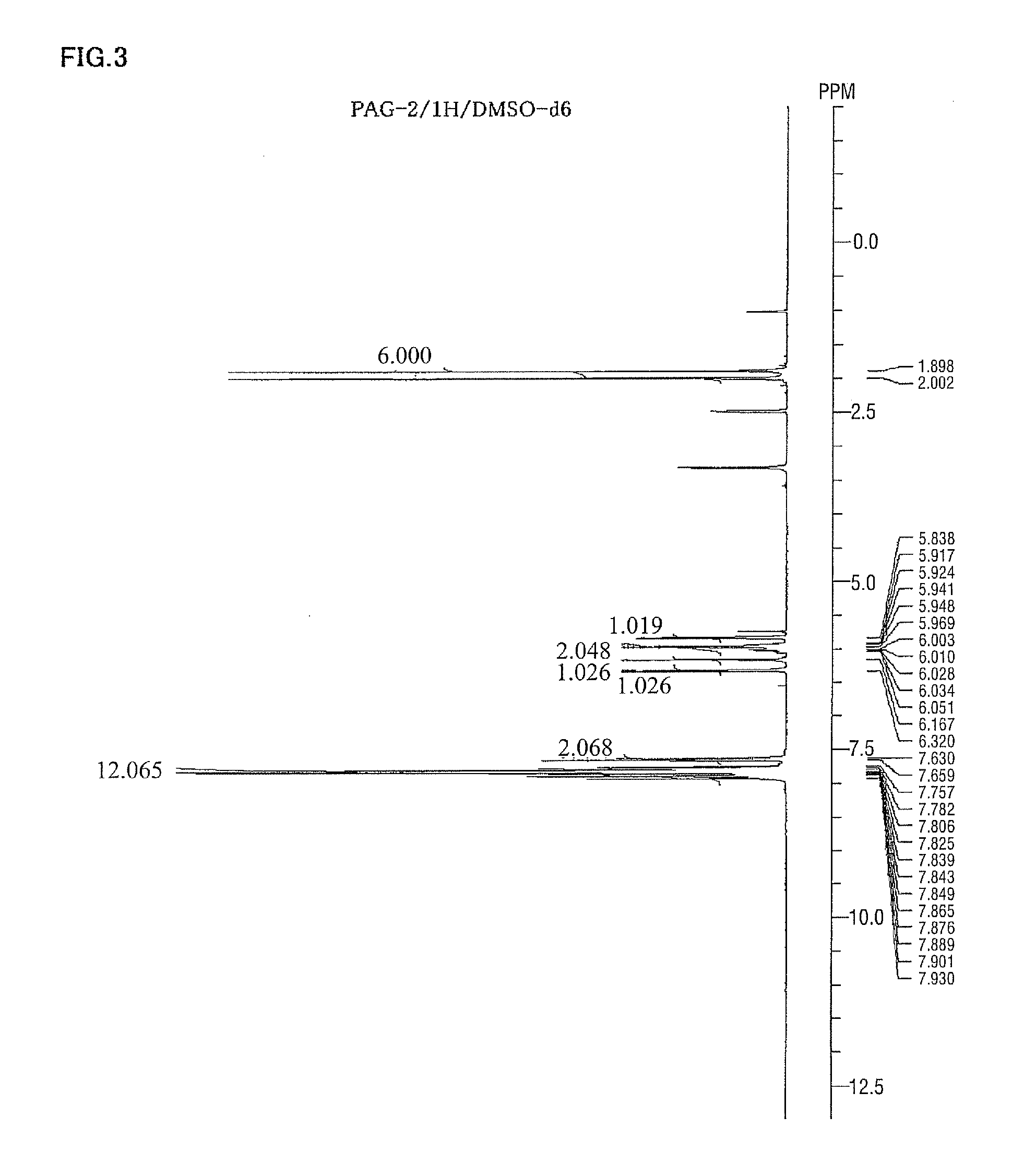Novel sulfonium salt, polymer, method for producing the polymer, resist composition and patterning process
a technology of sulfonium salt and polymer, applied in the direction of photosensitive materials, instruments, photomechanical equipment, etc., can solve the problems of insufficient acid strength to scissor acid labile groups on the resin, inability to perform resolution at all, and several retarded developmen
- Summary
- Abstract
- Description
- Claims
- Application Information
AI Technical Summary
Benefits of technology
Problems solved by technology
Method used
Image
Examples
synthesis example 1-1
Synthesis of 4-(2-methacryloyloxyethoxy)phenyldiphenylsulfonium 4-methylbenzenesulfonate
4-hydroxyphenyldiphenylsulfonium 4-methylbenzenesulfonate was used as a starting material, and the intended substance was synthesized according to the method disclosed in WO2007 / 069640. The intended substance was used for the next reaction as a crude substance.
synthesis example 1-2
Synthesis of triethylammonium 1,1,3,3,3-pentafluoro-2-(methacryloyloxy)propane-1-sulfonate
Triethylammonium 1,1,3,3,3-pentafluoro-2-(pivaloyloxy)propane-1-sulfonate prepared by the method disclosed in Japanese Patent Laid-Open (kokai) No. 2007-304490 is dissolved in methanol and 2 equivalents of 25 wt % aqueous solution of sodium hydrate was added thereto. After confirming a separation of a pivaloyloxy group by 19F-NMR, 2.1 equivalents of 12N hydrochloric acid was added and both methanol and water were removed by evaporation under reduced pressure, and then ethyl ether was added to the obtained residue to perform recrystallization. The crude substance containing sodium chloride was filtrated and then triethylamine (1.5 equivalents), 4-dimethylamino pyridine (0.025 equivalent) and acetonitrile (4 fold of the crude substance by weight) were added and the mixture was iced-cooled. Then, methacrylic acid anhydride (1.0 equivalent) was dropped and the mixture was stirred overnight. 3N hydr...
synthesis example 1-3
Synthesis of 4-(2-methacryloyloxyethoxy)phenyldiphenylsulfonium 1,1,3,3,3-pentafluoro-2-(methacryloyloxy)propane-1-sulfonate (PAG-1)
4-(2-methacryloyloxyethoxy)phenyldiphenylsulfonium 4-methylbenzenesulfonate of Synthesis Example 1-1 and triethylammonium 1,1,3,3,3-pentafluoro-2-(methacryloyloxy)propane-1-sulfonate of Synthesis Example 1-2 are mixed and ion-changed in a dichloromethane-water system. An organic layer after washing by water was concentrated under reduced pressure, the residue was purified by silica gel column chromatograph, and thereby the intended substance was obtained as an oily substance. The structure of the intended substance is shown below.
Spectrum data of the intended substance thus obtained are shown below. Results of the nuclear magnetic resonance spectra (1H-NMR, 19F-NMR / DMSO-d6) are shown in FIG. 1 and FIG. 2, respectively. Meanwhile, trace amounts of residual solvents (diisopropyl ether and water) are detected in 1H-NMR.
IR Spectrum (IR(KBr); cm−1): 1743, 17...
PUM
| Property | Measurement | Unit |
|---|---|---|
| Pressure | aaaaa | aaaaa |
| Pressure | aaaaa | aaaaa |
| Nanoscale particle size | aaaaa | aaaaa |
Abstract
Description
Claims
Application Information
 Login to View More
Login to View More - R&D
- Intellectual Property
- Life Sciences
- Materials
- Tech Scout
- Unparalleled Data Quality
- Higher Quality Content
- 60% Fewer Hallucinations
Browse by: Latest US Patents, China's latest patents, Technical Efficacy Thesaurus, Application Domain, Technology Topic, Popular Technical Reports.
© 2025 PatSnap. All rights reserved.Legal|Privacy policy|Modern Slavery Act Transparency Statement|Sitemap|About US| Contact US: help@patsnap.com



